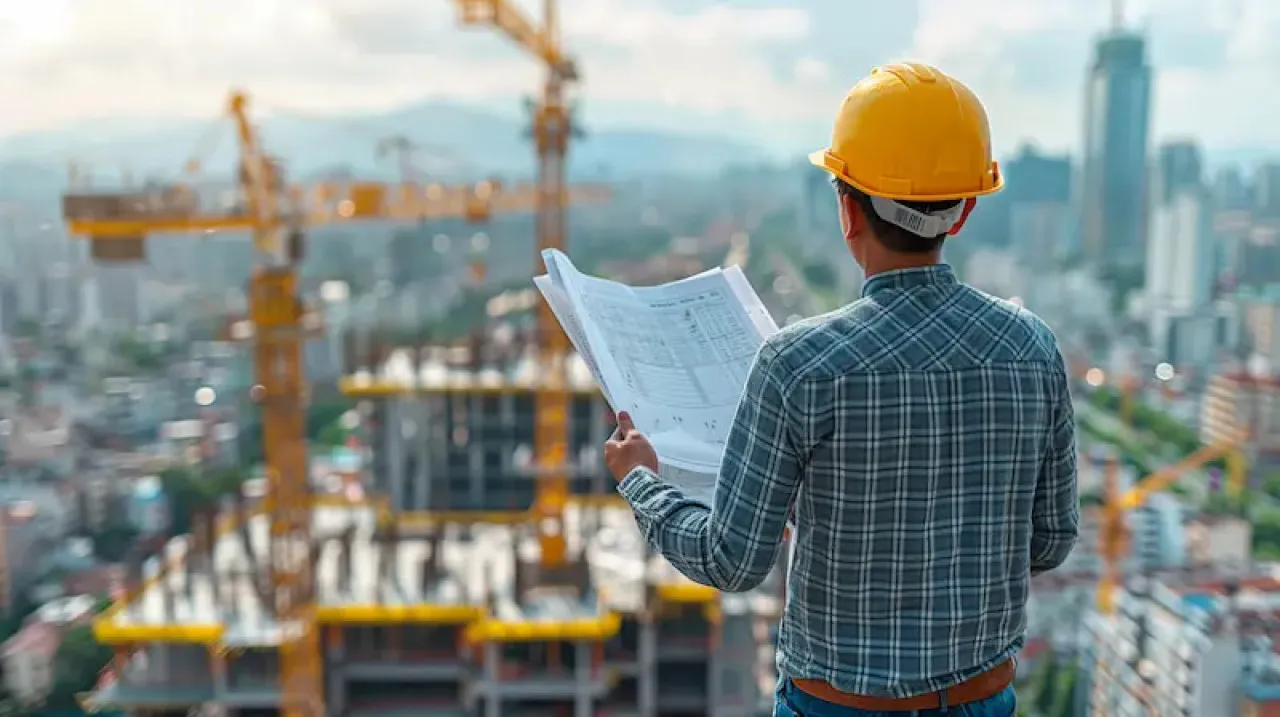Building construction refers to the techniques applied during the construction process to create strong, durable, functional, and economical structures or infrastructure. Understanding the basics of building construction is crucial for both architects and contractors.
Every stage of construction in a project involves more than just ensuring a building stands properly but it also requires consideration of other aspects. So, what should you know and pay attention to when understanding building construction? Let's explore further.
What Is Building Construction?
Building construction is a process involving the design, construction, and management of physical structures, which can include houses, buildings, bridges, highways, or other infrastructure.
This process includes various stages, from architectural planning, structural design, material selection and procurement, to the execution of construction on-site. It’s important to note that building construction is not just about stacking bricks and mortar.
It also involves technical considerations, such as how the load will be distributed throughout the structure, and ensuring the building is safe and meets applicable safety standards.
Additionally, construction involves legal and administrative aspects, such as obtaining permits, adhering to building codes, and overseeing the project.
All these efforts aim to create a structure that is not only functional and safe but also aesthetically pleasing and aligned with the needs of its owner or users.
Types of Building Construction Based on Function
In practice, there are several types of construction classified based on their function. Here’s an explanation:
Beam Construction
Beams are horizontal elements that play a crucial role in supporting the building’s load and distributing it to vertical elements like columns. Beam construction supports the floors, roof, or other loads above.
This type of building construction is divided into several types: overhanging beams, cantilever beams, simple beams, fixed-end beams, continuous beams, and suspended span beams.
Column Construction
Columns are vertical structural elements that support the load from the structure above and transfer it to the foundation. Columns must withstand significant compressive forces, especially in high-rise buildings where the load from each floor is transferred to the columns.
Column construction typically uses materials like reinforced concrete or steel, which have high compressive strength. Additionally, columns must be designed with considerations like seismic and wind loads that could affect the overall stability of the structure.
Concrete Slab Construction
Concrete slabs are flat structural elements typically used as floors or roofs. These slabs are usually supported by beams and columns and are designed to carry vertical loads from people, furniture, and other elements above.
This type of construction excels in strength, durability, and fire resistance, making concrete slabs ideal for high-rise buildings or public infrastructure like bridges and tunnels.
Stages of Building Construction
There are several stages in building construction that must be followed carefully to ensure the final result aligns with the plan. The detailed procedure includes the following:
1. Planning
The planning stage forms the foundation for the entire construction process. During this stage, various technical and administrative aspects are carefully considered.
Planning involves collaboration among architects, engineers, and project managers to design the building, determine technical specifications, and prepare project documents.
Additionally, cost and time estimates are developed at this stage to ensure the project proceeds smoothly without financial shortfalls or delays.
Effective planning also includes risk analysis to identify potential problems that could arise during construction and to develop mitigation strategies.
2. Execution
The execution stage is where planning is turned into reality. Physical work such as excavation, concrete pouring, installation of beams and columns, and laying of concrete slabs is carried out during this phase.
Coordination among various teams, including laborers, field engineers, and project managers, is crucial at this stage to maintain a smooth process and avoid mistakes that could have serious consequences.
3. Supervision, Maintenance, and Preparation for Use
After physical construction is completed, the building undergoes further supervision to ensure everything is following the plan and meets established safety standards.
Inspections and testing are conducted to check construction quality and ensure there are no structural defects or other issues. This stage also includes routine maintenance to keep the building in optimal condition.
Tips for Proper Building Construction
When constructing a building or infrastructure, it’s essential to ensure it fulfills its intended function. Therefore, several key factors must be considered to achieve optimal results. Here are some tips to follow:
1. Use High-Quality Materials
Choosing high-quality materials is crucial for any construction project. Premium materials offer better strength and durability, ensuring the building not only lasts longer but is also safer to use.
For example, using high-quality concrete can withstand heavy loads and is more resistant to cracking. One option for premium-quality concrete products is available from Semen Merah Putih.
2. Consider the Type of Technology Used
Construction technology continues to evolve, and utilizing the latest technology can bring numerous benefits to your project. For example, modular construction methods allow buildings to be constructed in prefabricated units, which are then assembled on-site.
This method is becoming increasingly popular because it significantly reduces construction time. Additionally, adopting new technologies like Building Information Modeling (BIM) can help in more efficient planning and collaboration among project teams.
3. Manage the Construction Budget
Managing the budget carefully is one of the most critical aspects of a building construction project. It’s important to conduct a detailed cost estimate, including material prices, labor costs, and additional expenses like permits and insurance.
A well-prepared budget helps avoid cost overruns that could negatively impact the project’s continuity. Moreover, it’s essential to prepare a contingency fund to address unforeseen situations that require additional expenses.
4. Building Layout and Architecture
A well-designed layout is essential to ensure that a building is not only functional but also comfortable and aesthetically pleasing. Good architecture considers efficient air circulation, natural lighting, ventilation, and the connections between spaces within the building.
An effective design also considers sustainability aspects, such as energy-efficient usage and environmentally friendly materials.
5. Estimate the Construction Time
Accurate time estimation is key to ensuring that the project is completed on schedule. Delays in construction can cause various issues, including cost overruns, client dissatisfaction, and the risk of damage to installed materials.
That concludes the explanation of building construction, along with the important types and stages to consider. As highlighted in the tips above, choosing high-quality building materials is crucial.
High-quality materials can support the final result in terms of both durability and structural integrity. Semen Merah Putih offers a range of concrete and cement products for your construction project.
Semen Merah Putih provides various types of concrete with premium quality, whether precast or ready-mix concrete. Additionally, we offer bulk cement products to meet your construction cement needs.
There are various types of cement available, whether for general construction or specialized projects, such as Semen Merah Putih ULTRAMIX, Semen Merah Putih SUPERMIX, and Semen Merah Putih DURAPRO.
For more information about Semen Merah Putih products, please fill out the contact form. So, what are you waiting for? Use Semen Merah Putih for stronger and sturdier construction.



